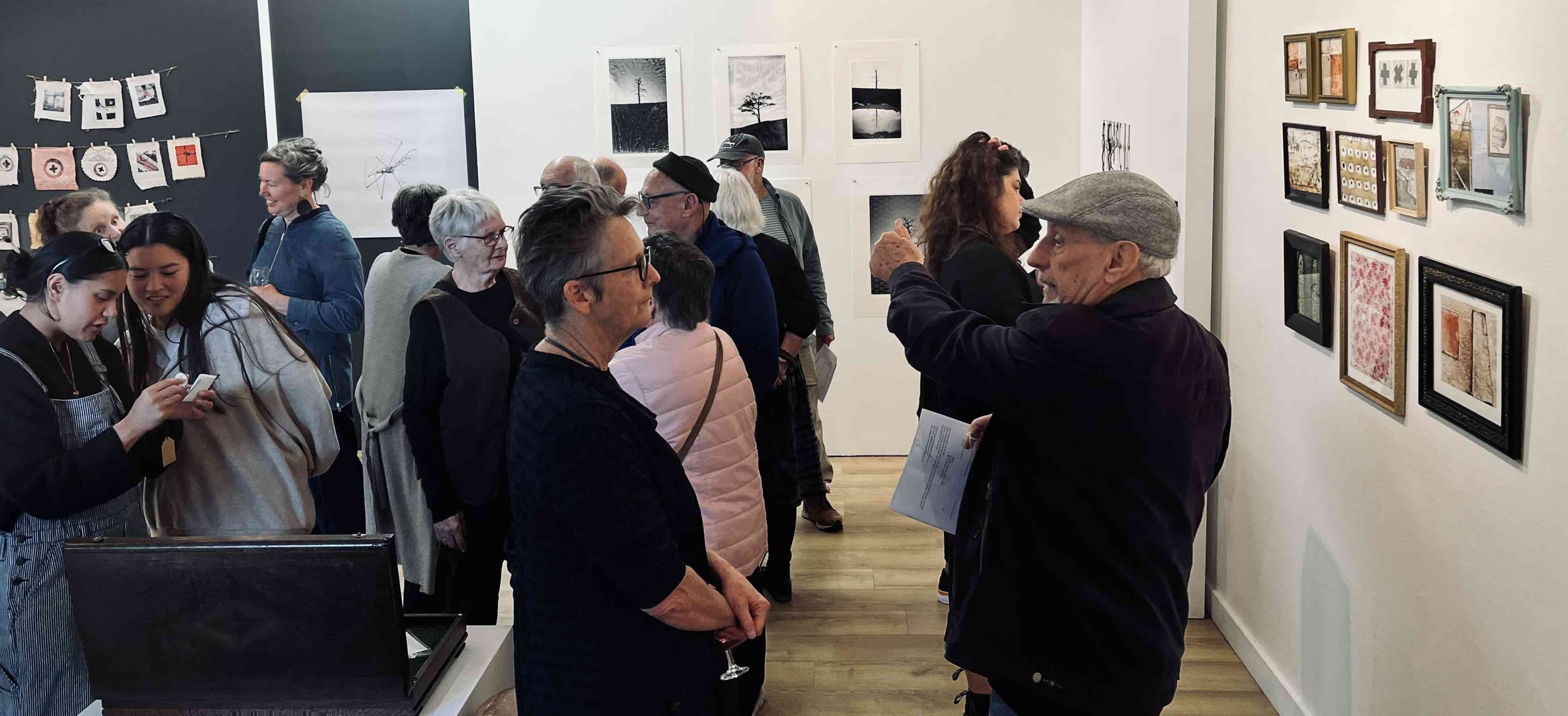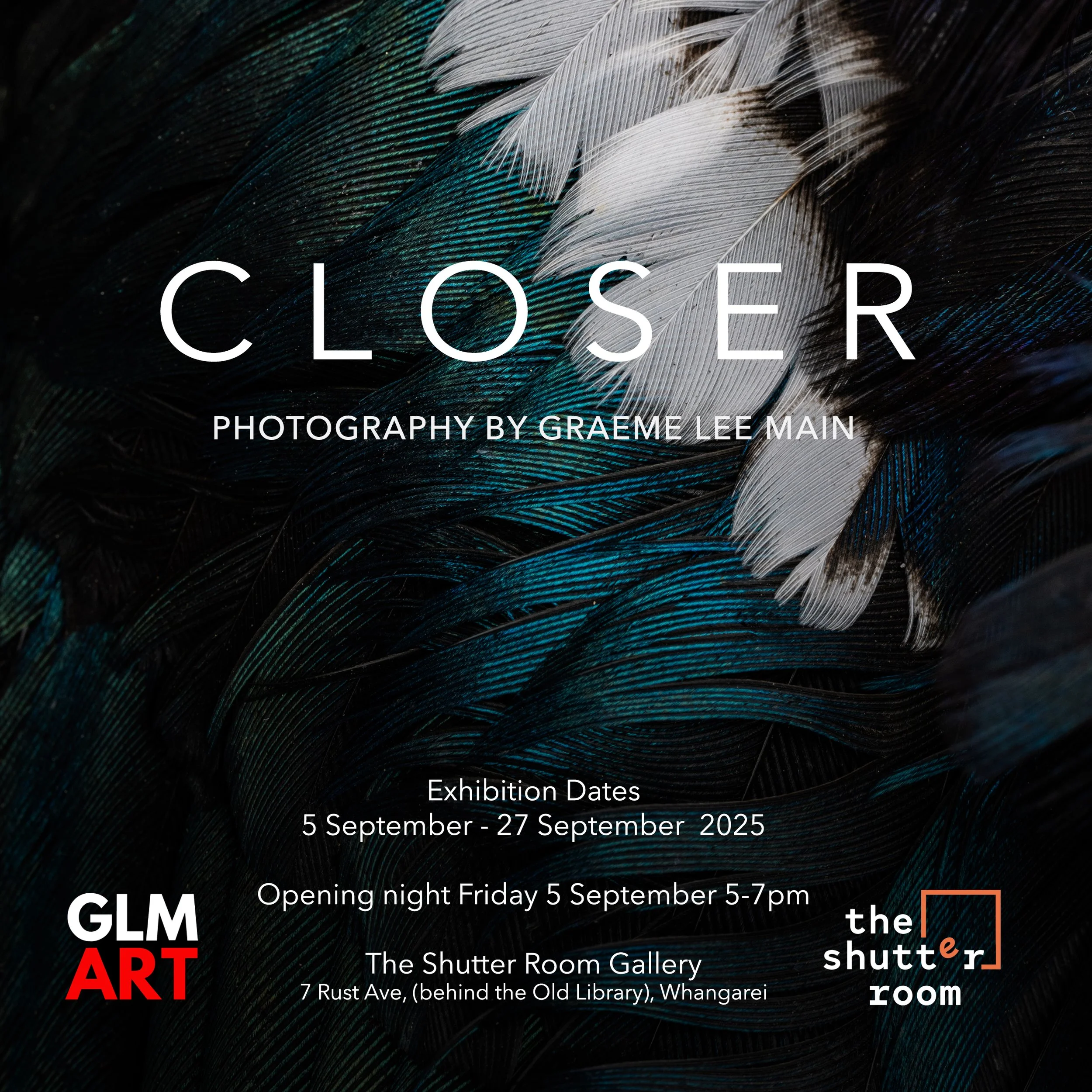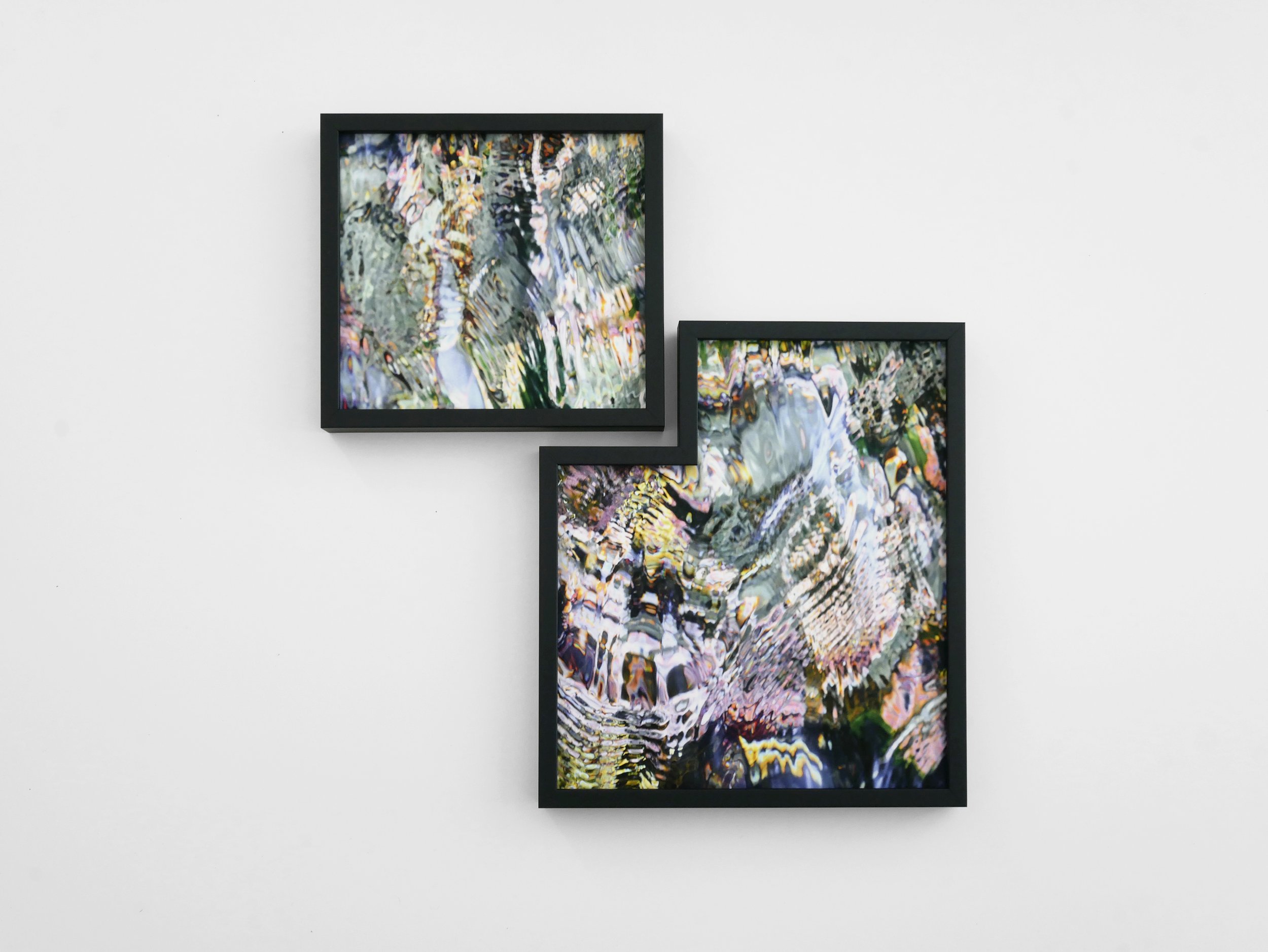
Upcoming Exhibitions

HOME - Shutter Room Members Show 2025-2026
Members of the Shutter Room Gallery and Collective are invited to submit one or two new works that connect with our 2025/26 theme, Home.
What does the word home mean to you? A home can be literal, the place in which you live, but is not limited to this.
The concept of the home can be a smell, a taste, a person/s, a feeling, or a memory. A home is a universal construct and can look very different for each individual. Context, culture, gender and sexual identity can all be factors in what our homes look like.
We can have many homes throughout our lives, not just the place we reside.
We are asking our members to explore and represent what Home looks like to you.

A Lovely Spot for a Cuppa - Chris Schreuder
A Lovely Spot for a Cuppa presents photographs printed onto used teabags, created during pauses in my work as a field representative travelling across Northland. These images capture beaches, rivers, and roadsides shaped by weather, tide, and time, then absorbed into stained, fragile surfaces that carry traces of daily ritual. Suspended to hang freely, the teabags shift with light and air, evoking the transient nature of these everyday pauses and inviting fresh ways of seeing the world.

Pioneers
Humans have long celebrated the pioneer spirit — settling new lands, shaping environments, and leaving lasting marks on culture and ecology. Yet, nature has its own pioneers: weeds and wild species that move into barren spaces, regenerating soil and life where it has been stripped away.
Pioneers reflects on these dual narratives, highlighting the tension between human ambition and ecological resilience. It invites audiences to rethink what it means to be a pioneer today, consider nature’s restorative power, and explore how we might live and create in ways that are sustainable and in balance.

CLOSER
Featuring over 20 original photographs, CLOSER employs techniques such as photostacking to reveal fine details often hidden from everyday perception. Graeme Lee Main’s images are marked by their intense clarity. Inviting viewers to look again, drawing them away from the familiar and into a space of curiosity, where the subject becomes abstracted and open to interpretation.

Ecologies
Ecologies brings together a collection of Northland artists whose work explores different local environments and the ways in which we interact and relate to them.


STUDIO. Alan Squires
Artist Residency @ The Shutter Room. Landscape and commercial work that celebrates Whangarei’s landscape and culture. A revolving and evolving studio exhibition, showing a selection of new and old works, plus new work in progress.
雙土海葬 DOUBLE BURIAL
Liu Shueng, Jie Ying Cai harvesting bamboo.
During the Lunar New Year and ahead of Waitangi Day this year, Māori and Chinese artists debut 雙土海葬 DOUBLE BURIAL in Northland.
The multimedia group exhibition, curated by 蔡杰盈 JieYing Cai, explores the unique relationship between Māori and Chinese underpinned by Te Tiriti o Waitangi through the shared rituals around death, burial and afterlife, inspired by the stories of the SS Ventnor.
This collaboration between Māori and Chinese artists brings together mahi raranga by Reva Mendes, sculpture by Angerlia Oliver, audiovisuals by JieYing Cai, Nathan Blundell and Michael Sue, and waiata by Eda Tang. The free exhibition will run from 2-28 February at The Shutter Room Gallery.
Don’t miss its launch on Sunday 2 February at 1pm.
About the artists
JieYing Cai 蔡杰盈
JieYing is a first-generation Chinese New Zealander with ancestors from Ganzhou 贛州. She is a multimedia artist currently residing in the Hokianga exploring themes of memory, identity and grief through craft making and photography. Curating this exhibition has been a journey of learning of language, tradition and returning to her own roots. JieYing was an attendee of Pāruru 2024.
Reva Mendes
Reva Mendes (Ngāpuhi, Te Rarawa, Te Aupōuri, Tainui), a passionate kairaranga (weaver) with whakapapa links to both sides of the Hokianga, has been involved in many kaupapa that connect her to other kairaranga and artists. A local Hokianga wahine, Mendes is the founder of Kōrari Enterprises, creating kōrari/harakeke paper with the aim of connecting and building the value chain within Indigenous plants and fibres and reigniting the fibre/textile industry within Te Tai Tokerau.
Eda Tang 唐子遥
Eda Tang is a second-generation Chinese New Zealander descending from Guangzhou, China. Based in Tāmaki Makaurau, she is a writer, a journalist, and a passionate language-revitalist. A student and teacher of Te Reo Rangatira, she combines her love of music and language in her waiata, Hokinga Oneone, a waiata submerging listeners in the grief of the spouses and children of the men whose bones never returned home. Tang attended the Pāruru journey in 2024.
Angerlia Oliver (Ange)
Ange Oliver (Muriwhenua, Ngāpuhi, Ngāti Tūwharetoa, Ngāti Raukawa ki te tonga), is also a mokopuna of Hana Toi, Ngāti Korokoro, Te Roroa. As a mature ākonga and emerging artist, Ange has just completed a Postgraduate Diploma in Māori Visual Arts through Toioho ki Āpiti. She was also the sole recipient of the Collin Post Memorial Scholarship in Sculpture in 2024. Recently her mahi toi has been an expression of mamae and aroha using natural materials and her own unique processes embedded with cosmological and customary knowledge. Her aim is to hold space for fragility and resilience that redresses cultural identity and belonging.
Exhibition Dates: February 2-28, 2025
Opening 1-3pm Sunday 2 February, 2025 (light refreshments available)
Exhibition leaflet, curator’s note.
Exhibition leaflet, brief history.
Jie Ying’s reflections
That is what Pāruru has lead to: Double Burial 雙土海葬. Somewhere along the line I had a dream. Hāmiora Bailey whispered to me, “ko wai ngā mokopuna”? (who are the descendants/grandchildren/future generation?). When there is a history involved, the work no longer becomes about me. It becomes about the ancestors, and the community that gather together for this living history.
In Chinese the word for mokopuna (descendant) is 後代 (generation behind), and the word for ancestor is 祖先 (generation in front). It’s a bit counter intuitive to have the future generation behind and ancestors in front. It reminds me of the whakatauki ‘ka mua ka muri’ (walking backwards into the future) and shared values of Chinese and Māori in the way which we respect our elders.
Double burial exhibition poster, design Lulu Qiu.
Double burial exhibition poster, design Lulu Qiu.
Rimurapa seaweed, cyanotype bamboo, taura muka, Jie Ying Cai.
Hokinga Oneone, waiata by Eda Tang.
Hokinga Oneone, explanation, Eda Tang.
The exhibition opening and gallery cultivated a space to practise tikanga Māori and share Chinese customs.
Double burial exhibition pōwhiri. Photo, Shervonne Grierson.
Omapere Rocks, cyantoype, silk, bamboo, muka taura.
Muka taura and bamboo
Special mention to the muka taura and bamboo symbolism in the exhibition. It was the first raranga/whatu (weaving) skill I learnt exactly a year again. It wove into the exhibition effortlessly. I was lucky to have attended a wānanga to learn muka striping and taura making skill shared by Ahi Nyx. This became a connection back to my 婆婆 pópó (maternal grandmother) before I had even realised. My mother flew from brisbane to come to the opening and as she walks in the door of the gallery she tells me her mother used to make rope that were bound around the soles of her shoes. These taura bound together the large bamboo I individually harvest and transported in my little demio from Hokianga to Whangārei. Bamboo being a resource for weaving and craft in China to build furniture, fans, bed mats, sieves. The house I grew up in China hung laundry of bamboo racks, which was a easy connection to back home.
Tamatea kai ariki, Kōrari paper, muka taura, bamboo, cyanotype, Reva Mendes and Jie Ying.
Kōrari paper, paper making
There is this memory with my grandparents standing behind my shoulder as I sat at the table with a calligraphy brush, dancing away with the ink on xuan paper (calligraphy paper). In this photo Reva and I are taking out of the kōrari fibre that has been boiled in her DIY bathtub with a gas stove below. Which we cast into a giant pool of fibre with a stretched mesh frame to make the Tamatea kai ariki cyanotype in the image above. In another world I’m making xuan paper in my hometown ganzhou. I wonder how paper mulberry making process adapted to the aute making process here in Aotearoa as a practise.
Reva Mendes and Jie Ying Cai making kōrari paper. Photo Jie Ying Cai.
Hokinga Mahara Pāruru, video still, Jie Ying Cai.
Dive, Cyanotype on silk, bamboo, muka taura. Photo, Jie Ying Cai.
Double Burial 雙土海葬 installation view. Photo Jie Ying Cai.
Kia tau, Ange Oliver. Photo Jie Ying Cai.
Kia tau, cotton , plaster, bamboo, muka taura, Ange Oliver. Photo Jie Ying Cai.
Kai
I think kai is a particularly important one to highlight for me. The discussion of what was on the bai san table had to be significant for the opening of the exhibition. The night before the opening I made 粽子 zòngzi sticky rice with dates wrapped in bamboo leaves. Story has it 粽子 zòngzi making is a tradition to throw into the river to feed the living so they don’t eat the dead. The living being the fish in the river. I grew up making 粽子 zòngzi with my mum and it was fitting to bring my food connection to the table. The crispy pork was a no given as “the roasting of a whole pig in a brick oven has been an important part of the food story for New Zealand’s Cantonese Chinese much of their 180-year history in Aotearoa.” 1 The ancestors like a bit of tradition, and crispy pork as always been a crowd favourite.
拜[baai3]神[san4] ceremony to pay respect to the ancestors at exhibition opening ceremony. Photo Shervonne Grierson.
Waiata tautoko after whaikōrero. Photo Shervonne Grierson.
Chinese bai san ceremony
The bai san ceremony at the opening was a offering to the ancestors. The three incense sticks represent heaven, earth and humanity. We bow three times holding the lit incense which then were placed in a couple buckets of sand I collected from Omapere beach. This is normally done at the burial places, and 清明 qingming festival but I’m sure the ancestors enjoyed the special outing to the gallery.
拜[baai3]神[san4] ceremony at the opening. Photo Shervonne Grierson.
Karakia whakamutunga
The first time I encountered Ralph Hotere was seeing his grave next to red gate memorial on Hione urupā in Mitimiti. Fast forward the page I opened in up in Ralph Hotere’s book was his piece Godwit/Kuaka 1977 that speaks the tauparapara RUIA RUIA OPEA OPEA TAHIA TAHIA. The meaning and these kupu have stuck with my brain as I relate them to the ancestors of the SS Ventnor in the making of Double Burial. How the manu arrive and settle on the sandbank, like visitors settling on the marae, like bones washing up on the tide lines of the west coast. The sowing of seeds like rain, scooped together then coming together in unison, sweeping. How this exhibition cultivated a space to practise tikanga Māori and Chinese death traditions.
Then having never meet Lenny (who was kaikarakia for closing the show), nor has he seen my work, opens with the same tauparapara from the far north. Goosebumps in that moment knowing our ancestors were with us. Then I responded with ka titiro atu au which we learnt at Pukenga Rau which is a waiata about the kuaka working in kotahitanga to migrate these far far oceans across to Hawaiki. When the kuaka seen to return north, they are setting out for Hawaiki, giving signs of melancholy
Lenny and Jie Ying at karakia whakamutunga. Photo Jie Ying Cai.
Many thanks to 雙土海葬 DOUBLE BURIAL sponsors, New Zealand Chinese Association Inc. Foundation North, and Creative Northland.

Sea of Love, Christina Little
An expanding body of work exploring the water at Pōneke's Taputeranga Marine Reserve presented in framed photographs, paper weaving and photomontage works.
About Christina Little
Christina Little is a Pōneke Wellington-based photographer best known for her colourful short series photographs of local water bodies. Her work captures the water’s edge and convergence zone where land meets water and its surroundings. Christina often visits the same location repeatedly, sometimes spanning many years. Christina’s photographs are vivid, colourful and full of playfulness, combining shape and form to create captivating and enchanting displays.
Christina has completed a number of solo photographic exhibitions and has been short-listed twice in the Waikato Museum National Contemporary Art Awards.

Spawned, Faye’Ala MacFarlane & Victoria Harrington
Spawned, An Exhibition by multidisciplinary artists
Faye’Ala MacFarlane & Victoria Harrington

DRAFT, Sandy Connon, Ellen Smith, Diane Stoppard
DRAFT, Sandy Connon, Ellen Smith, Diane Stoppard
An exhibition by three photographers that shares the diversity that comes from chasing an idea and exploring new processes in their studios.

Tim Morgan - The Photographer
A selection of Photographic Works by Tim Morgan Curated by Jade Morgan.

July Photo Studio Month
A month of Light Catchers with Ellie, workshops and members photo studio time.

Multiplicities, Group Exhibition
Curated by Angela Rowe and featuring work by Alan Squires, Anna Harding, Ashleigh Zimmerman, Ellen Smith, Faye’Ala MacFarlane, Gemma Keene, Jason Povey and Marcel Allen. Multiplicities is a group exhibition including artists and photographers who have been invited to create new work in response to the concept of Multiplicities.

Orlanda & Ruth, Elizabeth Corin
Opening Friday 3 May 5:30 - 7pm.
It all begins with an idea. Maybe you want to launch a business. Maybe you want to turn a hobby into something more. Or maybe you have a creative project to share with the world. Whatever it is, the way you tell your story online can make all the difference.







Shutter room solo unbounded (te hinengaro whakawātea)Sonja van Kerkhoff
shutter room solo unbounded (te hinengaro whakawātea) by Sonja van Kerkhoff

Sunsets, The Magnificent Eminence From Our Star, Tony Minett
"Light from the sun takes about eight minutes to travel to our planet, so when we see the sun as it sets, it has already gone during that eight-minute time delay; only its light remains."

Inside the Dead Box, Chris Schreuder
Inside The Dead Box is an exhibition of photographs of a small theatre-like space designed and constructed to house a world of slowly decaying and decomposing organic matter, with precious inorganic objects nestled in amongst the detritus.

Maggie Cocco’s Science for Sociopaths featuring Nimmy Santhosh
Maggie Cocco’s Science for Sociopaths featuring Nimmy Santhosh
Multimedia Experiment featuring music, photography, and audience.

Figure and Ground, making meaning in the Anthropocene
Curated by Angela Rowe and featuring work by Megan Corbett, Deborah Crowe, George Hajian, Gemma Keene, Vicky Little, Ros May, Mark Phobos, and Megan White.
Photographic technology has a history intertwined with photomontage, making it an excellent medium for challenging ideas around the authenticity of the photographic image. It is the perfect medium for creating images of a photographic nature that are impossible to make using traditional photographic equipment and techniques.

Things I Found Walking, Maggie Buxton
A collection of images of botanicals found on one of Maggie’s many walks along Beach Road in Onerahi. They document the cruel and altering process of pressing and drying away their life essence and then encasing them in crude bioplastic experiments.

Object (the physical image)
Object (the physical image) is the latest exhibition at the Shutter Room featuring the work of local artists Grant Beran, Maggie Buxton, Lisa Clunie, Sonja van Kerkhoff, Angela Rowe, Chris Schreuder, Ellie Smith & Diane Stoppard. These artists revel in the physical potential of an image - the materiality - the substance - the quality of a surface - the volume/dimension….the ‘thingness’ of their artwork. There is a perception that photography is like a window or a mirror - something we look through and therefore not interesting as a physical art object. This exhibition is a challenge to that notion - we invite you to come in and view the artworks on display and see what you think!

Making the Cut
Making the Cut features work by selected 2022 graduates from the very last cohort of the Bachelor of Applied Arts at NorthTec.

Street Art, Kennith Adams
The district is my home. Imperceptibly my attitudes softened first to benign tolerance then later to delight at the colour, form, wry observations, fun and laughter found in artworks that were slathered everywhere, over everything.

























